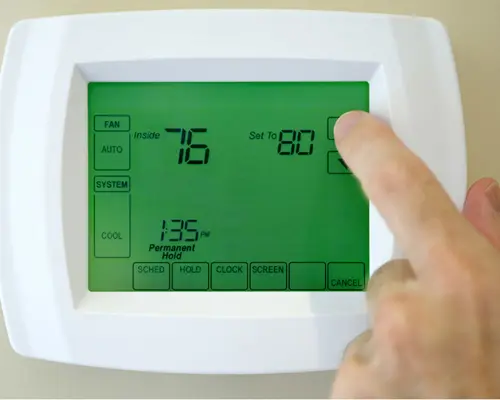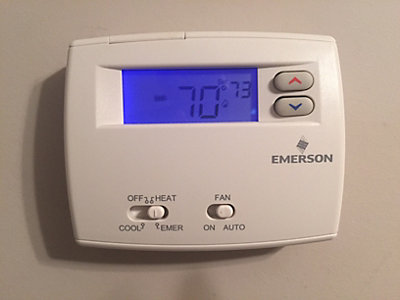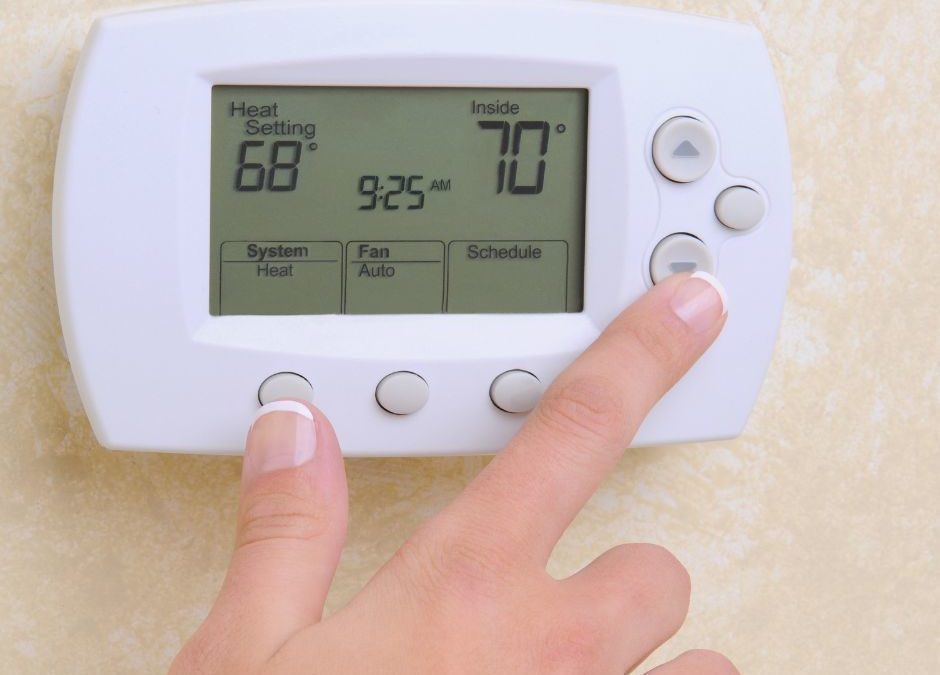Check Best Thermostat Pricing in Amazon
** As an Amazon Associate, I earn from qualifying purchases.
Setting your thermostat can be confusing. What is the best temperature?
Finding the right thermostat setting is important for comfort and energy bills. Many factors affect your ideal temperature, like season, time of day, and personal preference. A proper setting ensures you stay cozy without wasting energy. In this post, we’ll explore the best thermostat settings for different situations.
We will provide practical tips to help you find the perfect balance. Whether you’re looking to save money or stay comfortable, understanding thermostat settings is crucial. Let’s dive in and discover how to optimize your home’s temperature.
Optimal Temperatures For Winter
Setting the right temperature on your thermostat during winter can save energy and money. It also helps keep your home comfortable. Finding the balance between warmth and efficiency is key.
Daytime Settings
During the day, set your thermostat to 68°F. This temperature keeps your home warm while saving energy. If you feel cold, wear layers or use blankets. Using space heaters in occupied rooms can also help.
Nighttime Settings
At night, lower your thermostat to 60°F. This can help you sleep better and save more energy. Use warm bedding and pajamas to stay comfortable. If you have a programmable thermostat, set it to adjust automatically.
Ideal Summer Thermostat Settings
Finding the perfect thermostat setting in summer can be tricky. The goal is to stay cool without wasting energy. Balancing comfort and cost is key. Here are some tips for your ideal summer thermostat settings.
Cooling Efficiency
For cooling efficiency, set your thermostat to 78°F when you’re home. This temperature offers comfort while saving energy. Use fans to help circulate cool air. This can make you feel cooler without lowering the thermostat further.
When you’re away, increase the temperature by 7-10°F. This helps your system run more efficiently. Your air conditioner won’t work as hard, saving energy and money.
Energy Saving Tips
Consider using a programmable thermostat. Set it to adjust temperatures based on your schedule. This can save you up to 10% on cooling costs yearly.
Keep windows and doors closed to prevent cool air from escaping. Use curtains or blinds to block direct sunlight. This reduces the heat entering your home.
Regular maintenance of your air conditioning system is crucial. Clean or replace filters monthly. This ensures your system runs efficiently. Check for leaks or other issues that could reduce cooling efficiency.
Lastly, avoid using heat-generating appliances during the hottest parts of the day. Cook meals in the early morning or late evening. Use the microwave instead of the oven. This keeps your home cooler and reduces strain on your air conditioner.
Spring And Fall Recommendations
Set your thermostat to 68°F during the day in spring and fall. Lower it to 60°F at night for better energy savings.
Setting the right thermostat temperature during spring and fall can be a bit tricky. These seasons are known for their fluctuating temperatures, which can make your home feel chilly one day and warm the next. But with some practical tips, you can maintain comfort without running up your energy bill.Transitional Temperatures
Spring and fall are transitional seasons. You might wake up to a frosty morning, only to have it warm up by midday. This inconsistency can make it hard to find the perfect thermostat setting. During these times, try setting your thermostat to 68°F (20°C) during the day when you’re at home. It’s a comfortable temperature that shouldn’t require you to reach for a sweater. If you’re away from home or sleeping, lower it to around 60°F (15°C). This not only saves energy but also prevents your home from feeling stuffy.Balancing Comfort
Balancing comfort and energy efficiency is key. You don’t want to be too hot or too cold, and you certainly don’t want to see a spike in your energy bill. Consider layering your clothing. It’s easier to remove a sweater than to continually adjust your thermostat. This keeps you comfortable without overworking your heating or cooling system. Use natural ventilation. Open your windows during the day to let in fresh air and close them at night to keep the warmth in. This simple trick can help you maintain a comfortable indoor temperature. Finally, use a programmable thermostat. It can adjust the temperature automatically based on your routine. This way, you can set it and forget it, while still maintaining a pleasant environment. What other strategies do you use to stay comfortable during these transitional seasons?Adjusting For Humidity
Setting your thermostat between 72-78°F helps balance comfort and energy use. Adjust for humidity by keeping indoor air dry to enhance cooling.
Adjusting for Humidity Managing your home’s humidity is crucial for comfort and health. When it’s too humid, you feel sticky and uncomfortable. When it’s too dry, your skin and respiratory system can suffer. So, what should you set your thermostat to? Let’s dive into adjusting for humidity.Humidity Control
Humidity control involves more than just setting your thermostat. Humidity levels change throughout the year. In summer, high humidity can make your home feel warmer than it is. A dehumidifier can help. It removes moisture from the air, making you feel cooler. In winter, humidity levels drop. The air becomes dry, leading to chapped skin and respiratory issues. A humidifier adds moisture to the air. This makes your home feel warmer and more comfortable.Thermostat Integration
Modern thermostats can integrate with humidity control systems. This makes it easier to maintain the ideal environment in your home. Smart thermostats can monitor both temperature and humidity levels. They adjust automatically, ensuring your home is always comfortable. Do you have a smart thermostat? If not, it might be worth the investment. These devices not only control temperature but also manage humidity. This dual function can save you money on energy bills and improve your overall comfort. Next time you adjust your thermostat, think about the humidity levels too. A little adjustment can make a big difference in how comfortable you feel. What steps will you take to manage your home’s humidity better?Smart Thermostats
Set your smart thermostat to 68°F in winter to save energy. For summer, 78°F is recommended for comfort. Smart thermostats can help maintain these settings automatically.
Smart thermostats are revolutionizing the way we manage our home temperatures. These devices offer precise control over your home’s heating and cooling systems, allowing for greater energy efficiency and comfort. If you’re wondering about the best settings for your thermostat, smart thermostats can make the decision easier and more intuitive.Benefits Of Smart Thermostats
Smart thermostats come with a range of benefits that can make your life easier and your home more comfortable. Firstly, they learn your schedule and preferences. Over time, they automatically adjust the temperature based on your habits. Imagine coming home to a perfectly cooled house on a hot summer day without lifting a finger. Secondly, smart thermostats save you money. By optimizing your home’s temperature settings, you can reduce your energy bills. They even provide energy usage reports so you can see where you’re saving the most. Lastly, they offer remote control through your smartphone. Whether you’re at work or on vacation, you can adjust your home’s temperature with just a few taps on your phone.Programming For Seasons
Setting your thermostat for different seasons can significantly impact your comfort and energy consumption. In the winter, a good rule of thumb is to set your thermostat to 68 degrees Fahrenheit during the day. Lower it when you’re asleep or away from home. Smart thermostats can automate this adjustment, ensuring you don’t have to remember to change the settings manually. During the summer, aim for 78 degrees Fahrenheit when you’re home. Raise the temperature when you’re out. Smart thermostats can detect when you leave and adjust accordingly, keeping your home energy efficient. Have you ever forgotten to change the thermostat before leaving for vacation? With a smart thermostat, you can adjust the settings from anywhere. This can prevent unnecessary energy use and ensure you come back to a comfortable home. Overall, smart thermostats offer a blend of convenience, energy savings, and comfort that traditional thermostats simply can’t match. Have you considered upgrading to a smart thermostat? The benefits might just be worth the investment.
Credit: www.ars.com
Energy Saving Strategies
Setting your thermostat can be a game-changer for both your comfort and your wallet. You might not realize how much energy you can save with a few strategic adjustments. Let’s dive into some effective energy-saving strategies to help you manage your thermostat settings smartly.
Peak Hours Management
Peak hours are when energy demand and prices are highest. These are typically in the morning and evening. By adjusting your thermostat settings during these times, you can save significantly.
For instance, raise the thermostat by a few degrees in the summer and lower it in the winter during peak hours. This small adjustment can make a big difference. If you’re not home during these times, consider setting your thermostat to 78°F (26°C) in the summer and 68°F (20°C) in the winter.
Check Best Thermostat Pricing in Amazon
** As an Amazon Associate, I earn from qualifying purchases.
Do you use a programmable thermostat? You can set it to automatically adjust the temperature during peak hours. This saves you the hassle and ensures you never forget. Trust me, it makes a noticeable impact on your energy bill.
Temperature Variation
Did you know that slight temperature changes can lead to major energy savings? Adjusting the thermostat by just a few degrees can reduce energy usage without sacrificing comfort.
Try setting your thermostat to 68°F (20°C) when you’re home and awake in the winter. Lower it to around 60°F (15°C) when you’re sleeping or away. In the summer, aim for 78°F (26°C) when you’re home and higher when you’re out.
Test what works for you. Everyone has different comfort levels, so find a balance that keeps you comfortable while saving energy. Remember, every degree counts.
Have you ever noticed how much easier it is to sleep in a cool room? Lowering the temperature at night not only saves energy but can also improve your sleep quality. It’s a win-win!
What small adjustments can you make to your thermostat settings today? By being mindful of these strategies, you can enjoy a comfortable home and see a reduction in your energy bills.
Family And Lifestyle Considerations
Setting the thermostat to 68°F in winter and 78°F in summer balances comfort and energy savings. Consider your family’s daily routines and preferences. This helps maintain a pleasant home environment.
Choosing the right thermostat setting isn’t just about comfort. Your family and lifestyle play a crucial role in determining the ideal temperature for your home. Different members of your household may have varying needs, and it’s important to consider them to ensure everyone’s well-being.Children And Elderly
Children and the elderly are more sensitive to temperature changes. Babies and toddlers, for example, may not be able to regulate their body temperature as effectively as adults. Elderly people often have slower metabolisms, making them feel colder even when the room is at a moderate temperature. To keep everyone comfortable, aim for a consistent temperature. During the day, set the thermostat between 68°F and 72°F. At night, you might want to lower it slightly to around 65°F to promote better sleep. Think about the specific needs of your family. Does grandma always wear a sweater? Is your toddler frequently playing on the floor? These details can guide your thermostat settings.Pets And Plants
Pets also need a stable environment. Dogs and cats generally tolerate a range of temperatures, but extreme heat or cold can be harmful. Fish tanks and reptile enclosures often require specific temperature settings, so make sure to account for those. Plants can be another consideration. Tropical plants may thrive in warmer settings, whereas succulents prefer cooler temperatures. A good rule of thumb is to keep your home between 60°F and 75°F. Consider using programmable thermostats to adjust the temperature when you’re not home. This can save energy while keeping your pets and plants safe.Personal Preferences
Every family member may have their own comfort zone. Some people sleep better in cooler environments, while others might prefer it warmer. It’s essential to strike a balance that works for everyone. Communication is key. Discuss with your family what temperature feels comfortable for them during different times of the day. You might discover that minor adjustments can make a significant difference in everyone’s comfort. Do you have any tips or tricks for setting the thermostat in your home? Share your experiences in the comments below!
Credit: plumblineservices.com
Common Mistakes To Avoid
Setting the thermostat can seem simple. But, many people make common mistakes that lead to discomfort and higher bills. Knowing what to avoid can help you stay comfortable and save money.
Overadjusting Settings
One common mistake is overadjusting the thermostat settings. Many people crank the temperature up or down to quickly change the room’s feel. This puts extra strain on your HVAC system. It also leads to higher energy bills. Instead, make small adjustments. Give your system time to respond.
Ignoring Maintenance
Ignoring maintenance is another big mistake. Regular maintenance keeps your system running smoothly. Dirty filters, clogged vents, and worn-out parts make your system work harder. This uses more energy. It also shortens the lifespan of your HVAC system. Schedule regular check-ups with a professional. Change filters as recommended. Clean vents and ducts often. This keeps your system efficient and reliable.

Credit: smoakscomfort.com
Frequently Asked Questions
What Should I Set My Thermostat At In The Winter?
Set your thermostat to 68°F (20°C) during winter for energy efficiency and comfort. Lower it while sleeping or away.
Is 75 A Good House Temperature?
Yes, 75°F is a comfortable house temperature for many people. It balances warmth and energy efficiency.
Is 72 A Good House Temperature?
Yes, 72 degrees Fahrenheit is a good house temperature. It balances comfort and energy efficiency for most people.
What Is The Best Setting For Ac And Heat?
Set your AC to 78°F (25°C) in summer. For heating, keep it at 68°F (20°C) in winter.
Conclusion
Setting your thermostat correctly can save money and improve comfort. Aim for 68°F during the day and 60°F at night in winter. In summer, try 78°F when you’re home. Adjust the temperature based on your needs and preferences. Keep in mind that every degree matters for energy savings.
Experiment and find what works best for your household. Balancing comfort and efficiency is key. Regular maintenance and smart thermostats can help optimize your settings. Remember, small changes can make a big difference in your energy bills and overall comfort.
Check Best Thermostat Pricing in Amazon
** As an Amazon Associate, I earn from qualifying purchases.

